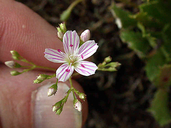Taxon Report
Lewisia serrata Heckard & Steb.saw-toothed lewisia |
 © 2002 Steve Tyron |
Taxon Summary
Lewisia serrata, commonly known as saw-toothed lewisia, is a perennial herb in the Montiaceae that is found only in California. It occurs within Broadleafed upland forest, Lower montane coniferous forest, and Riparian forest, growing at elevations from 770 to 1435 meters. Lewisia serrata is ranked 1B.1, Plants Rare, Threatened or Endangered in California and Elsewhere; Seriously threatened in California.Classification
|
Scientific Name: |
Lewisia serrata Heckard & Steb. |
|
Common Name: |
saw-toothed lewisia |
| Family: | Montiaceae |
| Element Code: | PDPOR040E0 |
| USDA Plants Symbol: | LESE3 |
|
Synonyms/Other Names: |
|
Ecology and Life History
| Lifeform: | perennial herb |
| Blooming Period: May-Jun | May-Jun |
| Elevation: | 770-1435 (2525-4710) |
| General Habitats: | Broadleafed upland forest, Lower montane coniferous forest, Riparian forest |
| Microhabitat: | Mesic, Rocky, Slopes |
| Microhabitat Details: |
Conservation Status
| CA Rare Plant Rank: | 1B.1 |
| Global Rank: | G1G2 |
|
State Rank: |
S1S2 |
| State List: | None |
| Fed List: | None |
| Other Status: | USFS_S |
|
CRPR Changes: |
|
Occurrence Data from the CNDDB
| Total Occurrences: | 11 |
| Element Occurrence Ranks: | |
| Excellent (A) | 1 |
| Good (B) | 2 |
| Fair (C) | 0 |
| Poor (D) | 0 |
| None (X) | 0 |
| Unknown (U) | 8 |
| California Endemic: True | |
| California Counties and Islands: Name (Code) | |
| El Dorado (ELD), Placer (PLA) | |
| Quads: Name (Quad Code) | |
| Devil Peak (3812085), Duncan Peak (3912025), Greek Store (3912015), Michigan Bluff (3912016), Pollock Pines (3812075), Riverton (3812074) | |
Threat List Data from the CNDDB
| Threat List Total: | 3 | |
| EOs with Threat Listed: | Total EOs | % of EOs |
| 3 | 27 % | |
| Over-collecting/poaching | 2 | 18% |
| Road/trail construction/maint. | 1 | 9% |
| Logging | 1 | 9% |
Notes
| Threatened by horticultural collecting and small hydroelectric power projects. Potentially threatened by recreational activities and road maintenance. See L. cantelovii in The Jepson Manual. See Brittonia 26:305 (1974) for original description, and Fremontia 25(1):15-19 (1997) for genetic study of relationship to L. cantelovii. |
|
Threats: |
|
Taxonomy: |
Citation
California Native Plant Society, Rare Plant Program. 2025. Rare Plant Inventory (online edition, v9.5.1). Website https://www.rareplants.cnps.org [accessed 27 December 2025].